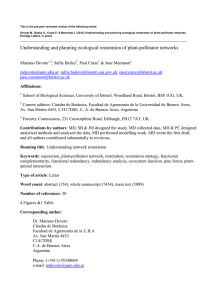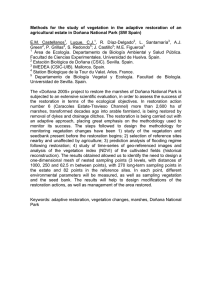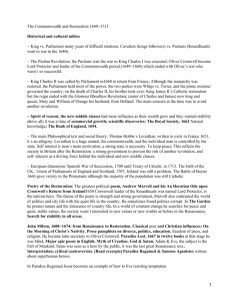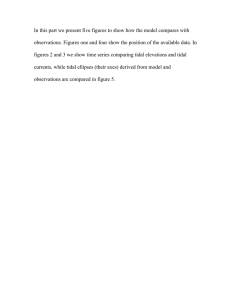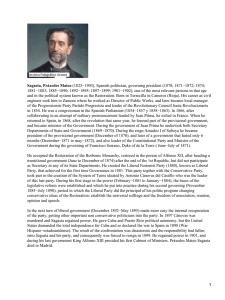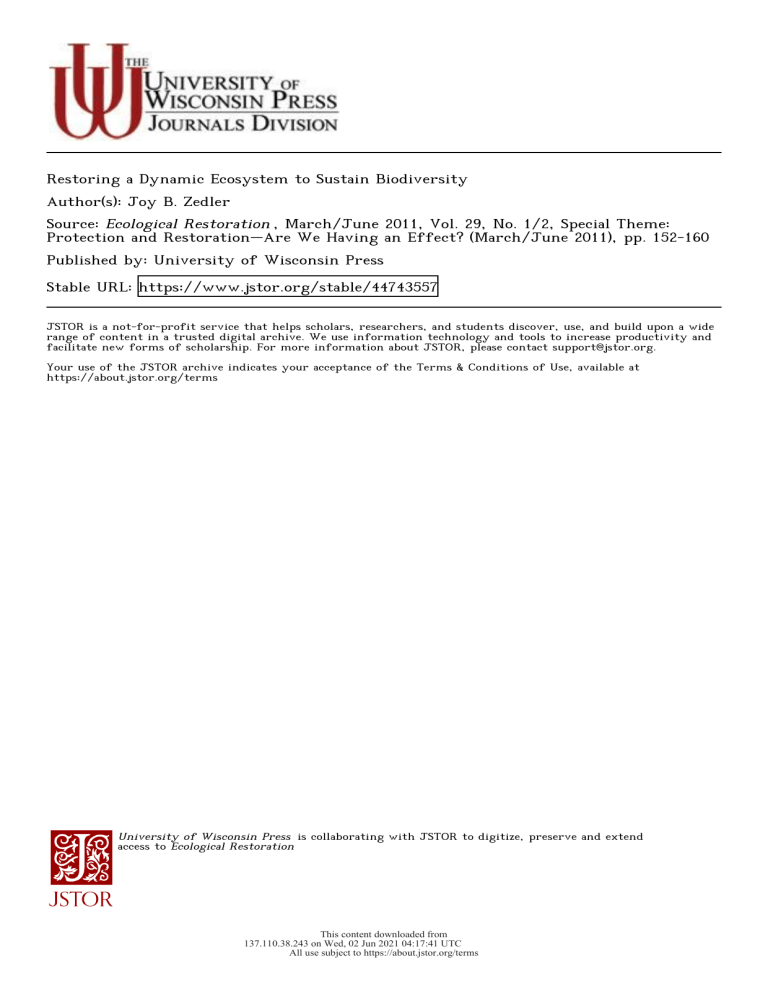
Restoring a Dynamic Ecosystem to Sustain Biodiversity Author(s): Joy B. Zedler Source: Ecological Restoration , March/June 2011, Vol. 29, No. 1/2, Special Theme: Protection and Restoration–Are We Having an Effect? (March/June 2011), pp. 152-160 Published by: University of Wisconsin Press Stable URL: https://www.jstor.org/stable/44743557 JSTOR is a not-for-profit service that helps scholars, researchers, and students discover, use, and build upon a wide range of content in a trusted digital archive. We use information technology and tools to increase productivity and facilitate new forms of scholarship. For more information about JSTOR, please contact [email protected]. Your use of the JSTOR archive indicates your acceptance of the Terms & Conditions of Use, available at https://about.jstor.org/terms University of Wisconsin Press is collaborating with JSTOR to digitize, preserve and extend access to Ecological Restoration This content downloaded from 137.110.38.243 on Wed, 02 Jun 2021 04:17:41 UTC All use subject to https://about.jstor.org/terms Restoring a Dynamic Ecosystem to Sustain Biodiversity Joy B. Zedier ABSTRACT Over three decades, Tijuana Estuary became highly modified by frequent storms and runoff events that acte with intensifying land use to deliver tons of sediment to the salt marsh and its tidal channels. The ma higher, drier, and more hypersaline, with fewer microtopographic features. The result was reduced bio an endangered sparrow continued to use the marsh plain, it was not permissible to remove sediment site. Thus, restoration took on new meaning, and efforts shifted to excavation of disturbed uplands an novel conditions. When subsequent excavations also accumulated sediment, planning expanded to lar restored in modules over decades. Sedimentation will likely recur during future stormy periods due to the Oscillation and global climate change. Thus, biodiversity will best be sustained within an adaptive restor involving large field experiments that show how to sustain all of the native species somewhere in the estu single module can provide all essential habitats. Keywords: flood, salt marsh, sedimentation, tidal influence, Tijuana Estuary Estuarieswetlands wetlandsareand vulnerable are vulnerable to floodother downstream to flood- ing and sedimentation during catastrophic storms. Given that climate is changing toward more frequent and extreme storm events, coastal But where sediments accumulate isfar hypothetically possible, but adaptation to novel conditions and continual faster than sea level rises, the marsh efforts plain can become elevated enough to to excavate new salt marshes shift tidal wetland to upland. from One uplands are more feasible alteror two plant species might adjust natives to for highly dynamic ecosystems. such rapid changes and expand Here, theirI present the Tijuana Estuary marshes can be expected to experience distributions, but most species will case be study, which offers both insights increased flooding and sedimentation. slow to accommodate change. and suggestions for future restoration. At the same time as vegetation For example, the intertidal marshes that develop at elevations between adjusts to sediment accretion, rare Tijuana and endangered bird species will be open mud flats and uplands have Estuary Experienced Increased nesting habFlooding and tidal creek networks that create het- further threatened if their erogeneous topography and support itat declines. Some might persist if a a mosaic of halophytes, but their per- preferred plant can sustain appropriate sistence requires that sedimentation rates keep up with rates of sea level rise. When sedimentation compensates for slowly rising sea level over decades to centuries, the vegetation can achieve relatively high diversity Tijuana Estuary is a 500 ha, marshnesting canopies, regardless of whether Sedimentation the salt marsh vegetation remains dominated ecosystem that is partly diverse. In either case, efforts to restore managed as the Tijuana River National Estuarine Research Reserve. rare plants are impaired, because resto- It the is representative of the Californian ration in the form of recontouring topography would not be permitted Biogeographic Region, which extends (although salt marshes [soil water >3% salt] are typically less diverse in plant in vegetation that either historically from Pt. Conception south along the supported endangered birds orBaja con-California Peninsula (Zedier et al. species than fresh [0-0.05% salt] or tinues to support their nesting. Just 1992). Semidiurnal mixed tides keep brackish [0.05-3% salt] marshes). how managers should respond to, theor estuary mouth open and the main channels saline. plan for, future salt marsh conditions Ecological Restoration Vol. 29, Nos. 1 -2, 201 1 and increasing rarity of several plant Of the two-dozen halophytes that species is uncertain. Periodic removal occupy the intertidal marshes, Pacific of sediments and reestablishment of cordgrass {Spartina foliosa) is the most ISSN 1522-4740 E-ISSN 1543-4079 ©201 1 by the Board of Regents of the University of Wisconsin System. historical structure and functioning inundation tolerant. It dominates the 152 # March/June 2011 ECOLOGICAL RESTORATION 29:1-2 This content downloaded from 137.110.38.243 on Wed, 02 Jun 2021 04:17:41 UTC All use subject to https://about.jstor.org/terms 1000-1 edges of channels and creeks but is often mixed with perennial pickle- 1982-83 900- weed (Sarco cornia pacifica = Salicornia virginica) at its inland boundary. Pick- ° leweed and ten other highly salt toler800- ant halophytes intermix on the broad marsh plain. Many of the nongrass species accumulate sea salts and are succulent. Collectively the creek-edge and marsh-plain vegetation provides nesting habitat for two endangered birds (light-footed clapper rail [Rallus longirostris levipes' and Belding s Savan- nah sparrow 'Ammodrammus sandwichensis beldingi ]). In the high marsh 1979-80 E J 600- I ~ 500- $ and transition to upland, subshrubs O and clonal grasses (Monanthochlöe lit- 1= 400- toralis, Distichlis spicata ) grade into coastal sage scrub. This infrequently inundated vegetation provides cover f sr 700- a> & 300- for the two endangered birds during 1994-95 the extreme high tides of winter and 200- summer, and it adds foraging habitat Î between nesting seasons. At Tijuana Estuary, monitoring occurs annually for the salt marsh vegetation, fish, channel inverte- brates, and soil salinity (Desmond et al. 2002, Zedier and West 2008) and continuously for channel salinity, dissolved oxygen, and temperature. The region has low average rainfall (<30 cm/y), but variability is high 100- o yf* - > *A| - 1950-51 1958-59 | 1966-67 1974-75 | 1990-91 1998-99 1954-55 1962-63 1970-71 1978-79 1986-87 2002-03 Figure 1. Annual streamflows (for rainfall years, July 1 through June 30) for Tijuan U.S.-Mexico border. U.S. Geological Survey data compiled by Janelle West (additio on flooding is in Zedier and West 2008). both seasonally, due to the Mediterra- nean-type climate, and over decades, due to the Pacific Decadal Oscilla- flowed from Goat Canyon onto the brackish to fresh following storms (Zedier and West 2008). tidal marsh plain, where they buried tion (PDO) (Bromirski et al. 2003). During the period of increased the benchmarks (steel pipes 20 cm storminess (1978 to 2005), aboveground) land use Although only recently described, the placed at Mean Higher PDO is widely recognized as a longchanged along with the growth High ofWater the by the U.S. Army Corps term pattern of benign conditions forhuman population in the watershed. of Engineers prior to 1974. A 50 cm tall concrete benchmark (TJE-43) was several decades followed by repeated The nearby city of Tijuana (in Mexico) half buried (Zedier 1983). Marsh soil quadrupled in population (Ganster episodic storms and flooding. A prime 2000), and hundreds of houses werealso recorded 25-30 cm of example is the coastal watershed of profiles accreted sediment based on Cs-137 the Tijuana River (Figure 1). Between packed onto steep, erodible bluffs 1950 and 1977, the 1,700 mi2 profiles (Weis et al. 2001). Broader and slopes just across the border (4,400 km2) watershed (mostly from in the estuary (which is entirely topographic surveys (Ward et al. 2003, Wallace et al. 2005, Zedier and West in the United States). Deep-rooted Mexico) discharged an average of 2.3 2008) andsoil cores of sediment plumes million m3 of fresh water per rainfall shrubs that might have held the year to the estuary, which was saline (Callaway and Zedier 2004) showed were removed and replaced by human that much of the marsh plain was (>3.4% salt) throughout that time structures and unpaved streets. The period (Purer 1942, Zedier 1977, rainstorms of January-February elevated1980 by at least 10 cm in recent Even a 5 cm difference in eleWinfield 1980). The average streamcaused one mudslide thatdecades. dumped 2 m of sediment into Goat Canyon flow for 1978 to 2005 jumped nearly vation can shift vegetation composition(Wil(Zedier 1977, Zedier et al. 1999, at the Mexico-U.S. border 50-fold to 113.9 million m3 (Figure liams and Swanson 1987). Sediments 1), and parts of the estuary became Varty and Zedier 2008). These recent March/June 2011 ECOLOGICAL RESTORATION 29:1-2 153 This content downloaded from 137.110.38.243 on Wed, 02 Jun 2021 04:17:41 UTC All use subject to https://about.jstor.org/terms sediment-accretion rates dwarfed rates Prior to 1978, estuary channels supThe Estuary's Diverse ported 29 species of fish, butSalt with Marsh Became of sea level rise of about 1-2 mm/y (Münk 2002, Scavia et al. 2002). frequent flooding, the fauna shifted Less Restorable In 1983 and 1995, the estuary was affected by major El Niño events in addition to the PDO. The 1983 sea salt- tolerant), short-lived species that could reproduce in one to twodespite years reintroduction of tidal flushing storm coincided with high tides, and toward a few euryhaline (broadly Biodiversity did not fully recover in December 1984. Cordgrass grew and persist despite disruption ( Zedier wave surges washed unstable dune et al. 1992). sand into the adjacent channel, sub- The 1984 nontidal drought killed stantially diminishing the estuary's crabs ( Pachygrapsis crassipes , Hemigraptidal prism and allowing the mouth sis oregonensis) and snails ( Cerithidea to close to tidal flushing in early April californica ), eliminating food used by 1984. The estuary remained nontidal the clapper rail. Simultaneous reduction in the extent and vigor of cordgrass reduced nesting habitat for the from the channels and rebuild the endangered bird, which either died or dune, in preparation for reopeningemigrated. Drought nearly extirpated the river/estuary mouth (Zedier et al.two short-lived, shallow-rooted plant 1992). The nontidal period coincidedspecies, sea-blite {Suaeda esteroa) and with an eight-month period with noannual pickleweed {Salicornia bigelo rainfall; warm dry weather caused highvii). Further support that tidal exclurates of evaporation that concentrated sion during drought caused extreme salt in channel waters (reaching 6% hypersalinity and loss of plant diversalt) and across the marsh plain (soil- sity came from a diked salt marsh near water salinity >10% salt, i.e., 3 times Ensenada, Mexico, where those effects that of seawater) (Zedier et al. 1992).were documented in the same year until mid-December 1984, while permits were obtained to excavate sand Tidal exclusion and drought led to (Ibarra-Obando and Poumian-Tapia the most stressful conditions ever documented at Tijuana Estuary. Extreme Events Reduced Native Biodiversity 1991). The series of extreme events had tall again by 1988, and clapper rails reestablished a viable population by 1991 (Zedier et al. 1992), but the tidal plain never recovered the diverse state recorded in 1974 (Figure 2). Instead of sustaining an abundance of short-lived plants (annual pickleweed and seablite), the plant community shifted to long-lived perennials. And instead of occurring in relatively even abundances, the perennials shifted toward two dominants, perennial pickleweed and salt marsh daisy ( Jaumea carnosa). No species was extirpated, but annual pickleweed was nearly eliminated, and both it and sea-blite are still rare where they were once common. Flooding and sedimentation associated with the next PDOs (which are cyclic), exacerbated by global change (which is directional), could eliminate one or both species from Tijuana Estu- severe and lasting impacts on the ary and perhaps from other coastal intertidal geomorphology, as well as its salt marshes in the region. Shortlived halophytes make the salt marsh estuarine biota. The changes in marsh resilient to other types of disturbance plain elevation and soil salinity are most well known, but there were also that create shallow depressions and Floods and drought had numerous influxes negative effects on native plants and of nutrients and contaminants canopy openings. Annual pickleweed animals. River flooding imported with every flood. While these chemi- can make an erodible tidal pool into cal influxes were not monitored, the a stabilized depression; sea-blite can nutrients and temporarily lowered soil salinity, which stimulated invasions of treatment plant on Tijuana grow tall stems that a Belding s Savansewage exotic rabbitfoot grass (PolypogonRiver mon (7 km upstream of the estu- nah sparrow can use to defend its nest. speliensis) and sickle grass ( Parapho - the U.S. side of the border We have yet to quantify the impacts of ary on their diminished distributions. lis incurva), both of which displaced with Mexico) has limited capacity native vegetation, especially in them3 per day), and it frequently Attempts to restore annual pickle(95,000 high marsh (Kuhn and Zedier overflowed, 1997, adding contaminants of weed and sea-blite by adding seeds to the natural marsh plain were ineffecunknown amounts to the sediment Callaway and Zedier 1998, Fellows tive (Vivian-Smith 2001, Morzariaand Zedier 2005). load. Layers of nutrient-rich sediment Low water salinities were lethal to overlain onto historical salt marsh soil Luna and Zedier 2007). We learned later that the critical microsites for stenohaline macroinvertebrates continued (those to support native vegeta- annual pickleweed are shallow (about with narrow ranges of tolerance tion to and endangered birds, but comsalt). For example, the sand dollar position and diversity understand- 5 cm deep) depressions, where water{Dendraster excentricus) population ably shifted toward fewer species and logging stresses perennial pickleweed crashed in 1978, and large purplegreater dominance - a condition that and allows the annual to germinate and grow. (Varty and Zedier 2008). hinged clams {Sanguinolaria nuttalli) is not easily reversed. Such depressions were filled by rapwere replaced by small individuals of idly accreting sediments. Without false mya ( Cryptomya californien) after the 1980 floods (Zedier et al. 1992). waterlogged microsites, perennial 154 # March/June 2011 ECOLOGICAL RESTORATION 29:1-2 This content downloaded from 137.110.38.243 on Wed, 02 Jun 2021 04:17:41 UTC All use subject to https://about.jstor.org/terms pickleweed remained dominant and 60-, salt marsh daisy persisted as a codomi- 4 ' nant (Bonin and Zedier 2008). Flood- ' ing in 2000 also inundated restoration plantings, coating young seedlings with sediment and impairing cord- grass establishment (Zedier et al. 50 - y 2003)€ One approach to marsh-plain restoration might have been to recontour the topography to historical elevations and variations, but neither grading nor excavating shallow depressions was permitted due to the continued presence of Beldings Savannah sparrows. This state-endangered bird nests in both diverse and monotypie (perennial pickleweed) salt marshes within the region, except where tidal influence is insufficient to discourage terrestrial predators on eggs and chicks. Nests are typically built just 3-6 cm aboveground (Powell and Collier 1998). Where inundation is infrequent, either due to estuary- mouth closure or sediment accretion 40- ļ 2O1 X : '' u ♦ 5 1 £ 30- ♦ V: 1 ' CU 't ' u ': 1 vi CU ' ' 'k'' 20 - I1V R k X.^^1974 10- ' x *'2004 ' ' 1994^Al, ' on the marsh plain, the soil dries and 1984' fox, dogs, and cats can find nests in salt marsh canopies that are less than 50 cm tall. While restoring salt marshes by low- ering marsh plains in their current location would potentially enhance the size and quality of habitat for the endangered birds, the short-term effect would be a loss of habitat already in use. In the long-term, with future o 1 2 3 4 5 6 7 8 9 10 11 12 13 14 Species sequence Figure 2. Dominance-diversity (= species-sequence) cur marsh-plain species over 31 years. The 1974 condition w marsh was depauperate in 1984, during nontidal drou recovery, with the marsh still dominated by Sarcocorni Jaumea carnosa emerging as a second dominant (Zedi PDOs and global change, the restored not be jeopardized. Two opportunities completing construction. Now, sand is periodielevated rates and frequencies of flood- that collects in the were basins a highly disturbed upland (the ing and sedimentation. An alterna- cally excavated and 0.7sold, ha Tidal Linkage, completed in but flooding still moves considerable material tive that was considered feasible and 1997) and afine former salt marsh that marsh plains would again experience recently implemented was to capture into the salt marsh. While the com- had accumulated 1-2 m of sediment sediments upstream in retention bined impacts of changing urban- (the 8 ha Friendship Marsh, combasins in Goat Canyon, on the U.S. ization and increased storminess are pleted in 2000). In each case, novel side of the border. However, the con- somewhat mitigated, the novel hydro- conditions posed new challenges. At the Tidal Linkage, the exposed struction of two sequential basins, at a logical conditions in the estuary have cost of $8 million, was not sufficient. not been reversed. marsh plain was raw subsoil, to which Sediment deposition on the marsh we added organic sediment from a November 2004, when the first storm will likely continue to exceed the rate former sewage lagoon to ameliorate of the season filled and overflowed of sea level rise, leading to continual harsh growing conditions. In April 1997 we planted eight halophytes in both basins, allowing excess sediment accretion relative to mean sea level. to flow across the southernmost salt This realization has led estuary man- near-equal numbers (-810 plants/ marsh. During 2005, the basins were agers to select restoration sites where species), but despite high initial surreexcavated and armored with rock, nesting by endangered species would vivorship, two of the species planted The project was nearly completed in March/June 2011 ECOLOGICAL RESTORATION 29:1-2 # 155 This content downloaded from 137.110.38.243 on Wed, 02 Jun 2021 04:17:41 UTC All use subject to https://about.jstor.org/terms clapper rails had been sighted among the cordgrass plantings. The historical salt marsh cannot be recontoured and the tidal channels of the Friendship Marsh cannot be reexcavated to their deep, wide origins because of endangered birds. The posi- tive outcome is that Belding's Savannah sparrows and light-footed clapper rails persist and use both restoration areas despite novel conditions and diminished plant diversity. The challenge is to provide new areas for valued wildlife to expand by creating suitable habitat to compensate for losses caused by sediment accretion. Managers realize the difficulty of sustaining Tijuana Estuary in a stable physiographic configuration. It is a small estuary affected by a large water- shed, and it will always be a dynamic ecosystem. With changing climate, Figure 3. Friendship Marsh, a large (8 ha) restoration experiment that was opened to tidal action in February 2000. The site encountered excessive sedimentation while testing effects of adding tidal creeks and allowing tidal pools to form. Replicated areas with and without tidal creek networks ( shaded ovals, left ) and tidal pools ( lower left) demonstrated that multiple scales of topographic heterogeneity aided restoration of habitat for both plants and animals. Dense plantings of Pacific cordgrass ( Spartina foliosa) formed a dark band between the mudflat and marsh plain (enlarged In lower right), although sparser plantings on the marsh plain were slow to establish and spread, a condition that favored shorebird feeding. The tidal creeks accreted sediment ( top right) but still provided fish access to the marsh plain. Tidal pools produced abundant invertebrates and became "feeding oases" at high tide (modified from Larkin et ai. 2006). became dominant; these were perennial pickleweed and salt marsh daisy. The same shift occurred in the adjacent natural marsh during the years of frequent flooding and sedimentation (Zedier and West 2008). Regardless, endangered terns, Savannah sparrows, and clapper rails used the Tidal Linkage. At the 8 ha Friendship Marsh (Figure 3), the exposed marsh plain was former wetland soil, albeit com- pacted. Tidal influence was not coastal California is expected to experience increased freshwater runoff of up to 25% by 2034 and 125% by 2099, with increased flashiness (Scavia et al. 2002). In anticipation of future PDOs and climate change, the prospects for sustaining biodiversity grow dimmer. Restoration Took added, presumably by holding moison New Meaning ture and increasing nutrient availability (O'Brien and Zedier 2006). Even if natural land forms and proThe Friendship Marsh was designedcesses are not restorable, salt marsh to have 50% low marsh and muddiversity and functioning can still be flat, 25% marsh plain and 25% high sustained. The typical goal of restoramarsh. Within five years, however, the tion is to return specific ecosystems mudflat accreted enough sediment to some former state. An alterna- to support marsh-plain vegetation, tive approach is to accept a site as a trapping the cordgrass between two novel environment that is irreversibly bands of higher elevation (Wallace altered. Restoration planners acknowl- et al. 2005). Also, a low spot along edge that much of Tijuana Estuary is the berm eroded and allowed flood- novel - either that novel conditions restored until mid-February 2000. borne sediments to accrete along theoccur where a site was historically With tidal restoration, seawater added west end of the excavated site. Despiteestuarine or that typical estuarine the intent to excavate an area that conditions currently occur in novel salt, but at that time of year, high would avoid sedimentation, accretion locations. For Tijuana Estuary, the rates averaged - 1-2 cm/y, an order oflargest areas available for restoration crust across most of the marsh plain. magnitude greater than the rate of seaare former agricultural lands within Cordgrass that was planted exten- level rise (Wallace et al. 2005). Whenthe river floodplain and are not yet urbanized. Their upstream location sively at the lower edge of the site the tidal creeks became constricted survived, especially in plots where aby sediment, we requested remedialreduces the potential to restore fully soil amendment (kelp compost) wasmeasures, which were denied because tidal conditions. tides were too infrequent to prevent the formation of an extensive salt 156 # March/June 2011 ECOLOGICAL RESTORATION 29:1-2 This content downloaded from 137.110.38.243 on Wed, 02 Jun 2021 04:17:41 UTC All use subject to https://about.jstor.org/terms To sustain biodiversity under novel conditions, it is necessary to track plant and animal populations and aim to rescue those that are most at risk, while simultaneously developing plans for a wide range of suitable habitats, either on site or elsewhere within the biogeographical region. At the large scale, varied topography can provide the heterogeneous landforms necessary for wetland species diversity (Morzaria-Luna et al. 2004). At the small scale, each species has slightly different requirements, so specific sites need to include a high variety of microsites, as in the regions most natural salt marshes (e.g., San Quintín Bay; Zedier et al. 1999). Even the tracks of bulldozers can provide topographic heterogeneity and differential wetting by tidal inundation, potentially supporting annual pickleweed (pers. obs.). Because 90% of the regions coastal wetland area has been filled and devel- oped, several dozen species of salt marsh plants and animals are considered sensitive or at risk of extinction (Zedier et al. 1992). With so many species threatened, a regional approach is needed to sustain all the native biota where they can best be sustained, even if they might not have occurred there historically. In other southern Cali- Figure 4. Conceptual plan to expand restoration at Tijuana Estuary. Sediments that have accumulated from multiple events over the past 30 years would be excavated to restore tidal marsh fornia lagoons and estuaries, projects and channel habitats and create a berm to limit future sediment accretion from severe floods are being coupled with redesigns of major coastal highways and bridges, of the Tijuana River. Several phases of restoration will be needed to complete this 100 ha effort (summarized from draft plans of the Tijuana River National Estuarine Research Reserve, 2007). and full tidal flushing can be restored (SCWRP 2007). Attempts to sustain biodiversity by providing habitat for all the species somewhere in the region contrasts with attempts to return specific ecosystems to some former state. Such an approach acknowledges the need to capitalize on novel conditions, such as a mudflat that accretes enough sediment to support marsh- Adaptive Restoration Allows Learning While Sustaining Salt Marsh Biodiversity Friendship Marsh (Figure 5) indicated the need to restore topographic heterogeneity in order to restore diversity. The design (replicate areas with and without tidal creek networks) Adaptive restoration involves a phased and the large experimental units approach with each module designed (-1 ha) led to research funding and with knowledge gained in previous rigorous testing of hypotheses about phases. Ambitious plans (Figurehalophyte 4) plantings, algae, inverte- call for 100 ha of habitat restoration to brates, and fish (Madon et al. 2001; be implemented in modules as funds O'Brien and Zedier 2006, Larkin et and it requires that we acknowledge and sediment-disposal sites become unknowns and use restoration sites al. 2008, 2009). The following series of questions illustrates how future to test alternative techniques for sup-available. Designing each module experimentation within an adaptive porting native species and providingas an experiment allows procedures to improve with time and outcomes restoration framework could refine ecosystem services. to come closer to expectations. restoration For efforts under novel and plain vegetation and sparrow nesting, example, experimentation at the 8dynamic ha conditions. March/June 2011 ECOLOGICAL RESTORATION 29:1-2 # 157 This content downloaded from 137.110.38.243 on Wed, 02 Jun 2021 04:17:41 UTC All use subject to https://about.jstor.org/terms completed. If indentations gradually erode to form creeks, and if wind fetch and bioturbation cause pools to form on the marsh plain, costs of providing heterogeneous topography would be reduced. Will intertidal pools degrade over time? Outcomes will differ where sedi- ment supplies are rich (as at Tijuana Estuary) or scarce (as in Sweetwater Marsh National Wildlife Refuge, San Diego Bay) and where sedimentation interacts with vegetation encroach- ment to fill in microsites. A mosaic of pool types (shallow to deep, at both low and high intertidal elevations) could be established initially to test for persistence and biodiversity support. How should salt marsh plants be planted in restoration sites? Only perennial pickleweed recruited withFigure S. Friendship Marsh topography 42 months after excavation (compare with conceptual ovals with and without tidal creek networks in Figure 3, left). Mudflat and marsh plain areas that were initially uniform were altered in elevation by sedimentation; tidal creek excavations were diminished in depth and width by sediments; a few new creeks formed due to erosion, and pools developed following resuspension and redistribution of sediments (modified from Wallace et al. 2005). Vegetation has since developed - as intended across the marsh plain and unintended across the elevated mudflat. out being planted into the Friendship Marsh (Morzaria-Luna and Zedier 2007). Other species with limited dispersal capacity need to be planted to avoid monotypie vegetation. However, the only planting approaches we have tested are propagule type (Sul- Which relative distribution of salt halophytes (Batis maritima , Jaumea livan 2001), use of a kelp-compost marsh habitats constitutes a sustaincarnosa :) would expand vegetatively soil amendment, and varied spacing (O'Brien and Zedier 2006). Because more rapidly than others by sending able geomorphological state? While clustered seedlings showed promise in runners over the edges of the islands geomorphological changes were docuand trapping sediment to build the enhancing canopy cover, the technique mented at Friendship Marsh, hydrocould be refined with further tests of dynamics need further understandmarsh plain. Plantings of cordgrass could also enhance accretion rates spacing and varied assemblages. ing. Future excavations call for the (Ward et al. 2003) and minimize Have the restored salt marsh food 50:25:25 geomorphological pattern, salt crust formation. Future experiwebs developed the complexity of but small "designer marshes" could those in natural marshes? West and ments could compare islands with test alternative proportions of low, others (2003) characterized the food rough versus smooth surfaces, as well mid, and high marsh, as well as a as islands of multiple depths and dynamic alternative, namely overexcaweb leading to fish, but birds are often elevations. vation to increase mudflat initially and the desired restoration target. Huspeni and Lafferty (2004) developed a food allow subsequent sedimentation andDo tidal creeks need to be incised or can they be jump-started to extendweb indicator using the list of tremahydrodynamic forces to "self-design" on their own? Although the 8 ha site todes that parasitize salt marsh snails the topography. Can islands of densely planted was precision-graded to create repli-to indicate the alternative hosts that cate tidal creek networks, the creeks are also present. This rapid indicator vegetation accelerate marsh-plain shifted over time, shrinking in cross-can be used to compare food webs of formation using an overexcavation approach? Marsh-plain formation sectional area and expanding in length restored and natural marshes, as well and number within six years (Wal-as restoration sites of different age and might be jump-started by leaving lace et al. 2005). Future experimenta- other characteristics (e.g., Whitney et islands of higher topography to accrete sediment. Small islands could be left tion could involve excavating only an al. 2007). Further experimentation indentation at the creek mouth. The with tidal creek and pool topograat the marsh-plain elevation, and spe- potential for pools to form via self-phy could include snail parasites as a cies other than perennial pickleweed could be introduced in dense clusters. design could also be tested by leaving response variable over time and among A reasonable hypothesis is that two rough surfaces after bulldozer work is geomorphological treatments. 158 M March/June 2011 ECOLOGICAL RESTORATION 29:1-2 This content downloaded from 137.110.38.243 on Wed, 02 Jun 2021 04:17:41 UTC All use subject to https://about.jstor.org/terms What role does nitrogen limitation play in the interactions of key halophytes? Species distributions, greenhouse and field experimentation, and microcosm experiments all indicate References human population, limited wastewa- ter treatment facilities, exposed Bonin, soils, C. and J.B. Zedier. 2008. Plant traits and plasticity help explain abunand heavy runoff. During a threedance ranks in a California salt marsh. decade period of storminess, Tijuana Estuaries and Coasts 31:682-693. that arrow grass ( Triglochin concinna ; Estuary experienced repeated flooding Bromirski, P.D., R.E. Flick and D.R. and sedimentation. Extreme flood- sometimes lumped with T. maritima) ing and drought reduced plant and subdues perennial pickleweed and animal diversity, which did not fully facilitates growth of annual pickle- recover between events. The presence Callaway, J.C., G. Sullivan and J.B. Zedier. 2003. Species-rich plantings of resident endangered birds prohib- weed by concentrating nitrogen in its tissues (especially roots) and releasing nitrogen from senescing leaves in spring, when the annual can benefit Cayan. 2003. Storminess variability along the California coast: 18582000 .Journal of Climate 16:982-993. ited the removal of most sediments, so historical conditions could not be restored. increase biomass and nitrogen accumulation in a wetland restoration experiment. Ecological Applications 13:1626-1639. (Zedier 2001, Morzaria-Luna 2004, Sullivan et al. 2007). Plantings of varied species combinations could plant species recover their losses. Restoration took on new meaning as plan- native perennial ( Salicornia virginica) further test this hypothesis at larger ners acknowledged that conditions and an exotic annual {Polypogon mon- spatial and temporal scales. were novel, and that continual action speliensis) under varied salinity and hydroperiod. Wetlands Ecology and Does restoring tidal flushing during the winter high tide and rainy season Nor did efforts to replant selected and more ambitious plans would be needed to sustain all of the species (November- December) increase somewhere in the estuary, or at least voluntary establishment by diverse native plants or enhance dominance by perennial pickleweed? We know that most salt marsh plants set seed in late fall or early winter and most within the region. Adaptations to novel conditions included trapping are not tidally transported (Morzaria- Luna and Zedier 2007). Tests of hydrochory timing (water dispersal of seeds) and transport could help res- torationists schedule projects to take advantage of, or avoid, colonization by the aggressive perennial pickleweed. Does the restoration of plant diver- sediments upstream, providing topo- graphic heterogeneity by excavating nearby upland sites to create tidal creeks, mudflats, and marsh plains, and transplanting propagules of species in jeopardy. Given many unknowns and uncertain future conditions, an adaptive res- Callaway, J. C. and J.B. Zedier. 1998. Interactions between a salt marsh Management 5:179-194. marshes: Lessons from southern fornia. Urban Ecosystems 7 : 1 07 Desmond, J., D. Deutschman an Zedier. 2002. Spatial and temp variation in estuarine fish and i tebrate assemblages: Analysis o 1 1-year dataset. Estuaries 25: Fellows, M. and J.B. Zedier. 2005 of the non-native grass, Paraph lis incurva (Poaceae), on the ra endangered hemiparasite, Cord maritimus subsp. maritimus (S toration framework will allow learning lariaceae). Madroño 52:91-98. tion? Ecologists typically address this while restoring salt marshes to sustain biodiversity. By designing each restoration phase as an experiment, researchers can address critical ques- Ganster, P., ed. 2000. San Diego question by measuring plant produc- tions, gain insights into cause-effect tivity and testing for complementary relationships, and help land stewards sustain biodiversity. sity increase salt marsh ecosystem func- use of resources. At Tijuana Estuary, high-diversity plantings were initially the most productive (Callaway et al. 2003), but the pattern faded over time Acknowledgments I thank Dr. Ron Thom for inviting this (Doherty et al., unpub.). Other critical contribution. Thanks to local environmen- functions might increase with diver- tal activists and managers, most of Tijuana sity, however, and larger plots could Estuary is protected as a National Estuatine Research Reserve, designated by the National Oceanic and Atmospheric Administration (NOAA); it is also a Ramsar Wet- test effects of diverse plantings on arthropod and bird use, as well as soil development, carbon sequestration, and overall ecosystem resilience. land of International Importance. This overview summarizes the research of many International Border Area Plan Atlas. San Diego CA: San Dieg University Press. Huspeni, T.C. and K.D. Lafferty Using larval trematodes that pa ize snails to evaluate a saltmars ration project. Ecological Appli 14:795-804. Ibarra-Obando, S.E. and M. PoumianTapia. 1991. The effect of tidal exclusion on salt marsh vegetation in Baja California, México. Wetlands Ecology and Management 1:131-148. Kuhn, N. and J.B. Zedier. 1997. Differential effects of salinity and soil sat- uration on native and exotic plants of a coastal salt marsh. Estuaries 20:391-403. Larkin, D.J., S.P. Madon, J.M. West and collaborators. I am grateful for funding from NOAA (Sea Grant, Coastal Ocean J.B. Zedier. 2008. Topographic het- Program, NERR Monitoring Awards and Tijuana Estuary is a small, dynamic Graduate Fellowships), Earth Island Institute, and the National Science Foundation estuary with a large watershed charac(DEB-02 12005). terized by a variable climate, a growing experimentally-restored tidal marsh. Conclusions erogeneity influences fish use of an Ecological Applications 1 8 :483-496. Larkin, D.J., G. Vivian-Smith and J.B. Zedier. 2006. Topographic March/June 2011 ECOLOGICAL RESTORATION 29:1-2 & 159 This content downloaded from 137.110.38.243 on Wed, 02 Jun 2021 04:17:41 UTC All use subject to https://about.jstor.org/terms heterogeneity theory and ecological restoration. Pages 144-164 in D. Falk, M. Palmer and J.B. Zedier (eds), Foundations of Restoration Ecology. Washington DC: Island Press. Larkin, D., J. West and J.B. Zedier. 2009. Created pools and food availability for fishes in a restored salt marsh. wetlands. Ecological Applications J.G. Titus. 2002. Climate change 17:1694-1702. impacts on U.S. coastal and marine Williams, P.B. and M.L. Swanson. 1987. ecosystems. Estuaries 25:149-164. Southern California Wetlands Recovery Tijuana estuary enhancement hydroProject (SCWRP). 2007. State Coastal logic analysis. Oakland: California State Coastal Conservancy. Conservancy, Oakland CA. www Winfield, T.P. 1980. Dynamics of carbon .scwrp.org Sullivan, G. 2001. Establishing vegetation and nitrogen in a southern California Ecological Engineering 35:65-74. Madon, S.P., G. D. Williams, J.M. West salt marsh. Ph.D. dissertation. Univer- lands. Pages 119-155 /«J.B. Zedier sity of California, Riverside, and San Diego State University, San Diego. (ed), Handbook for Restoring Tidal Wetlands. Marine Science Series. Boca Zedier, J.B. 1977. Salt marsh community and J.B. Zedier. 2001. The importance of marsh access to growth of Raton FL: CRC Press. the California killifish, Fundulus parvipinnisy evaluated through bioener- in restored and created coastal wet- structure in the Tijuana Estuary, Calif. Estuarine and Coastal Marine Science Sullivan, G., J. Callaway and J.B. Zedier. 5:39-53. 2007. Plant assemblage composi- getics modeling. Ecological Modelling 136:149-165. tion explains and predicts how biodi- Morzaria-Luna, H. 2004. Determinants of mally hypersaline marshes. Estuaries 6:346-355. Ecological Monographs 77: 569-590. Varty, A. and J.B. Zedier. 2008. How Zedier, J.B., ed. 2001. Handbook for for restoration of ecosystem funcRestoring Tidal Wetlands. Boca Raton waterlogged microsites help an FL: CRC Press. tion. Ph.D. dissertation, University of annual plant persist among salt Wisconsin, Madison. marsh perennials. Estuaries and CoastsZedier, J.B., J.C. Callaway, J. Desmond, 31:300-312. G. Vivian-Smith, G. Williams, G. SulMorzaria-Luna, H., J.C. Callaway, G. Sullivan and J.B. Zedier. 2004. RelaVivian-Smith. 2001. Developing a frame- livan, A. Brewster and B. Bradshaw. versity affects salt marsh functioning. plant species assemblages in the Californian marsh plain: Implications tionship between topographic het- work for restoration. Pages 39-88 in erogeneity and vegetation patterns in J.B. Zedier (ed), Handbook for Restor- tion: An improved model of spatial pattern. Ecosystems 2:19-35. ing Tidal Wetlands. Boca Raton FL: a Californian salt-marsh. Journal of Vegetation Science 15:523-530. Morzaria-Luna, H. and J.B. Zedier, 2007. Does seed availability limit CRC Press. 30:12-25. Münk, W. 2002. Twentieth century sea level: An enigma. Proceedings of the National Academy of Sciences 99:6550-6555. Zedier, J.B., H.N. Morzaria-Luna and K. Ward. 2003. The challenge of Wallace, K.J., J.C. Callaway and J.B. Zedier. 2005. Evolution of tidal creek plant establishment during salt marsh restoration? Estuaries and Coasts 1999. Californian salt marsh vegeta- restoring vegetation on tidal, hypersaline substrates. Plant and Soil networks in a high sedimentation environment: A 5-year experiment at 253:259-273. Zedier, J.B., C.S. Nordby and B.E. Kus. 1992. The ecology of Tijuana EstuWard, K.M., J.C. Callaway and J.B. ary: A National Estuarine Research Zedier. 2003. Episodic colonization Reserve. Washington DC: NOAA Tijuana Estuary, California. Estuaries 28:795-811. O'Brien, E. and J.B. Zedier. 2006. Accel- of an intertidal mudflat by a native Office of Coastal Resource Man- cordgrass {Spartina fo liosa) at Tijuana Estuary. Estuaries 26:1 16- 130. agement, Sanctuaries and Reserves berg. 2001. Vertical accretion rates ing diversity in natural and restored salt marshes: A 30-year study of Division. erating the restoration of vegetation in a southern California salt marsh. Zedier, J.B. and J.M. West. 2008. DeclinWeis, D.A., J.C. Callaway and R.M. Gers- Wetlands Ecology and Management 14:269-286. and heavy metal chronologies in wetland sediments of the Tijuana Estuary. Estuaries 24:840-850. Powell, A. and C. Collier. 1998. Reproductive success of Belding s Savan- Tijuana Estuary. Restoration Ecology 16:249-262. nah sparrows in a highly fragmented West, J., Williams, G., Madon, S.P. and landscape. The Auk 1 15:508-513. Zedier, J.B. 2003. Integrating spatial and temporal variability into the Purer, E. 1942. Plant ecology of the coastal marshlands of San Diego County, California. Ecological Monoçnraphs 12:81-111. Scavia, Donald, J.C. Field, D.F. Boesch, Robert W. Buddemeier, V. Bur- analysis of fish food web linkages in Tijuana Estuary. Environmental Joy Zedier is Professor of Botany and Aldo Leopold Chair in Restoration Ecology at Biology of Fishes 67:297-309. Whitney, K.L., R. Hechinger, A. Kuris the University of Wisconsin , Madisony and K.D. Lafferty. 2007. Endangered She can be reached at the University of kett, D. Cayan, M. Fogarty, M. Harwell, R. Howarth, C. Mason, D.J. Reed, T.C. Royer, A. H. Sallenger and light-footed clapper rail affects para- Wisconsin , Botany Depty 430 Lincoln Dr ; site community structure in coastal Madisony Wl 53706t [email protected]. 160 # March/June 2011 ECOLOGICAL RESTORATION 29:1-2 This content downloaded from 137.110.38.243 on Wed, 02 Jun 2021 04:17:41 UTC All use subject to https://about.jstor.org/terms

